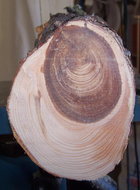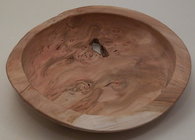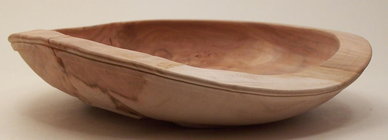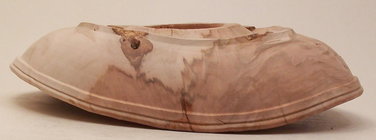I'm working on a piece of hard maple root wad stock. It's spalted and very dry. I believe it must contain minerals because my tools dull quickly. Its super hard with grain going every which way. I finished the outside of a bowl, mounted it in the chuck I was surprised at how much it had moved. It almost seems to move with every pass of the gouge. The upper part is about 1/8 of an inch out of round. My experience with cherry and walnut have never been like this. Does root stock wood have more tension than wood from the trunk of the tree generally? Do you think there may be something else going on? I've checked the chuck and it's snug and not moving. Have you ever had a piece of wood move more than others?
-
It's time to cast your vote in the December 2025 Turning Challenge. (click here for details) -
Congratulations to Pat White for "Sicilian Mosaic" being selected as Turning of the Week for December 29, 2025 (click here for details) -
Welcome new registering member. Your username must be your real First and Last name (for example: John Doe). "Screen names" and "handles" are not allowed and your registration will be deleted if you don't use your real name. Also, do not use all caps nor all lower case.
You are using an out of date browser. It may not display this or other websites correctly.
You should upgrade or use an alternative browser.
You should upgrade or use an alternative browser.
Tension in Wood
- Thread starter Dave Fritz
- Start date
That is nothing new especially in root as you turn away wood you release captured stress.
I don’t have it with me, but I’m pretty sure Ellsworth has a small section in his book about turning different parts of trees (roots, trunk, branches, etc…). Aside from movement with cambium/bark, he mentioned root wood as the most extreme and unpredictable. Someone correct me if I’m wrong
Just got home and checked the book. I SORT of remembered correctly. Ellsworth talks about root wood being softer and more flexible than other portions of the tree. Given that, it makes sense that it would warp dramatically as the drying fibers are relieved of stress.Ellsworth…mentioned root wood as the most extreme and unpredictable. Someone correct me if I’m wrong
- Joined
- Jan 27, 2005
- Messages
- 13,188
- Likes
- 5,769
- Location
- Dalworthington Gardens, TX
- Website
- pbase.com
The movement is not unusual. Before you started removing material the internal stresses were in equilibrium. If the internal compression and tension stresses are high enough, the wood will either move or crack as you remove material from the rootball. I turned an oak rootball that had a very high mineral content and the only way that I was able to cut it was with carbide tools. Highspeed steel would go dull almost instantly.
Roots/root burls don't grow evenly, and also have more sap in them than the heartwood in most all cases, so drying can give you more tension than in the regular wood, also depending where/how the tree grew can give you more compression and tension, and that will come out and show when you are working it and removing some of that wood.
Here is. a piece that I cut and it shows extreme tension and compression wood, if you would cut this vertically as shown in the picture, you will get a lot of distortion.

Then here is a Canada plum root burl that I got and that I turned and carefully dried in my paper bag routine, and you can see the distortion it got (no splitting), it is probably the worst case I've had with warping, though I've had a few more that did distort quite a lot.



As for minerals, that is possible and also grown in sand and even rocks in that root burl wood, it doesn't take much to dull a tool with that stuff in the wood.
Here is. a piece that I cut and it shows extreme tension and compression wood, if you would cut this vertically as shown in the picture, you will get a lot of distortion.

Then here is a Canada plum root burl that I got and that I turned and carefully dried in my paper bag routine, and you can see the distortion it got (no splitting), it is probably the worst case I've had with warping, though I've had a few more that did distort quite a lot.



As for minerals, that is possible and also grown in sand and even rocks in that root burl wood, it doesn't take much to dull a tool with that stuff in the wood.
Last edited:
I've done large hollow-forms with walnut root-ball. I had to leave the walls over 1.25" thick to allow for the wacky warps.
While hollow-forms can be spectacular, in a lot of respects they are less challenging than bowls - the hollow-form "contains" the warp while the bowl does not.
There was a wood-turner in Houston, Russell was his last name, that did a white-paper on relieving stress by boiling for 1-hour for each inch thickness - while it did NOT prevent warping, it did significantly reduce cracking.
I boiled each "rough" for about 2-hours over the last 15-years - it's a pain but it works. If you try boiling, never never pull the rough out of hot water - remove it the next day - removing it hot can be dangerous plus it can crack more.
The really cool part is: the piece dries much faster after boiling.. Of course that takes you into 2-stage turning: roughing, boiling/drying, and then re-turning
While hollow-forms can be spectacular, in a lot of respects they are less challenging than bowls - the hollow-form "contains" the warp while the bowl does not.
There was a wood-turner in Houston, Russell was his last name, that did a white-paper on relieving stress by boiling for 1-hour for each inch thickness - while it did NOT prevent warping, it did significantly reduce cracking.
I boiled each "rough" for about 2-hours over the last 15-years - it's a pain but it works. If you try boiling, never never pull the rough out of hot water - remove it the next day - removing it hot can be dangerous plus it can crack more.
The really cool part is: the piece dries much faster after boiling.. Of course that takes you into 2-stage turning: roughing, boiling/drying, and then re-turning
